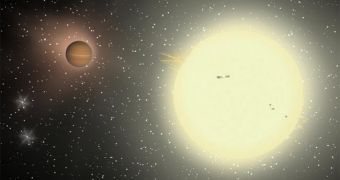A newly discovered planet proved to be the biggest known planet outside of the Solar System. The new planet is located in the Hercules constellation and it was a surprise even for the astronomers. "We continue to be surprised by how relatively large these giant planets can be," says Francis O'Donovan.
The planet is about 70 % larger than Jupiter, which is the largest planet in our Solar System, and has a smaller mass meaning that it has a very low density.
The new biggest one has a density of 0.2 grams per cubic centimeter which means, at least in theory, that it could float on water.
The dimensions of this planet can be hardly explained by the actual theories on superheated giants and it's a theoretical problem for the scientists to explain its existence because it is so large, compared to its mass. But explaining the existence of these huge planets in their rough environments can clarify the formation of our Solar system and its planets.
The new planet was discovered by astronomers searching for transiting planets. A transiting planet is a planet which passes directly between the Earth and the star obstructing a part of the star's light and slightly reducing its brightness. "TrES-4 blocks off about 1% of the light of the star as it passes in front of it," said Dr Mandushev. "With our telescopes and observing techniques, we can measure this tiny drop in the star's brightness and deduce the presence of a planet there."
The newly discovered planet, called TrES-4 makes a complete revolution around its star every 3.55 days. In short, a year on the planet TrES-4 is shorter than a week on Earth.
But not only the newly discovered planet is extremely fascinating for scientists; its star is also very interesting to study. As Georgi Mandushev explains: "The host star of TrES-4 appears to be about the same age as our Sun, but because it is more massive, it has evolved much faster. It has become what astronomers call a 'subgiant', or a star that has exhausted all of its hydrogen fuel in the core and is on its way of becoming a 'red giant', a huge, cool red star like Arcturus or Aldebaran."

 14 DAY TRIAL //
14 DAY TRIAL //